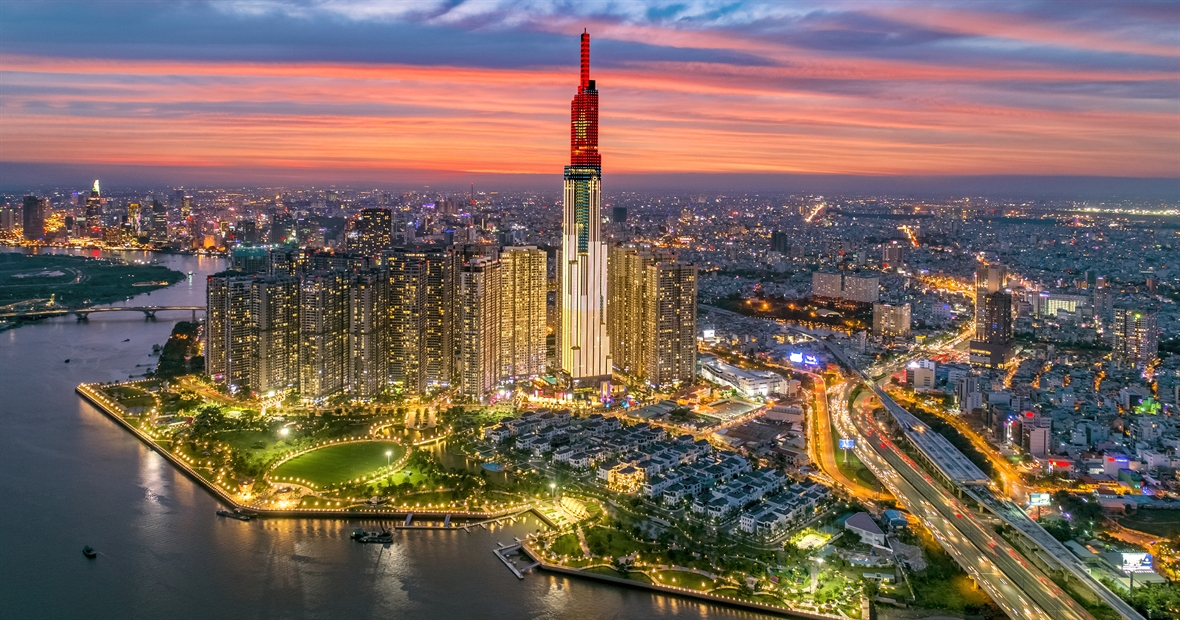How many urban regions will Vietnam have by 2030? Which cities are regional central urban areas of Vietnam by 2030?
How many urban regions will Vietnam have by 2030? Which cities are regional central urban areas of Vietnam by 2030?

How many urban regions will Vietnam have by 2030? Which cities are regional central urban areas of Vietnam by 2030? (Image from the internet)
How many urban regions will Vietnam have by 2030?
On August 22, 2024, the Prime Minister of the Government of Vietnam issued Decision 891/QD-TTg approving the Urban and Rural System Planning for the period 2021 - 2030, with a vision to 2050.
This includes the content approving the planning for spatial organization of the urban system with 04 urban regions of the country by 2030 as follows:
(1) Hanoi Urban Region
This is a large urban region including provinces and centrally governed cities such as: Hanoi, Hai Phong, Quang Ninh, Hung Yen, Hai Duong, Bac Ninh, Vinh Phuc, Ha Nam, Bac Giang, Thai Nguyen, Hoa Binh, and Phu Tho.
The aim is to build and develop Hanoi Capital as a national growth pole and nearby urban areas of the provinces in the Red River Delta, the midland and northern mountainous region to share functions related to education, training, healthcare, science, technology, commerce, services, tourism, and to limit excessive concentration in the central urban area of Hanoi, in line with the ecosystem of the Red River and Thai Binh River basins.
The focus is on developing synchronized, modern urban infrastructure and connectivity infrastructure to enhance rapid connection capabilities between Hanoi and Hai Phong, Ha Long, as well as large urban areas in the region (Vinh Yen, Bac Ninh, Phu Ly, Thai Nguyen, Hoa Binh, Hung Yen, Hai Duong, Bac Giang cities are secondary growth poles in the region); completing ring roads 4, 5 of Hanoi Capital Region and urban railways, eastern ring railway of Hanoi city, preparing infrastructure for connection and development of a second airport south of the Capital Region, promoting economic-social connectivity and development spillover for the entire northern region. Forming industrial, urban, service belts along ring roads 4, 5 of Hanoi Capital Region, national highway 18, highway 5 Hanoi - Hai Phong, Hanoi - Quang Ninh.
(2) Ho Chi Minh City Urban Region
This large urban region includes provinces/cities: Ho Chi Minh City, Binh Duong, Dong Nai, Ba Ria - Vung Tau, Tay Ninh, Binh Phuoc, Long An, Tien Giang.
The aim is to build and develop Ho Chi Minh City as a national growth pole and nearby urban areas of provinces in the Southeast region and Mekong Delta to share functions related to services, industry, education - training, healthcare, science - technology, to limit excessive concentration in the central urban area of Ho Chi Minh City, in line with the ecosystem of the Dong Nai River and Mekong River basins.
Building rapid connection corridors from Ho Chi Minh City to large urban areas (Thu Dau Mot, Bien Hoa, Vung Tau, Tan An, My Tho cities are secondary growth poles in the region); completing ring roads 3, 4 and urban railways, railway connections with airports, international gateway ports, promoting economic-social connectivity and development spillover for the entire southern region. Forming industrial - urban - service belts along ring roads 3, 4. Developing Long Thanh international gateway airport city.
(3) Da Nang Urban Region
Includes Da Nang City, Hue City, and nearby urban areas from Quang Nam, Quang Ngai, Binh Dinh provinces.
The aim is to build and develop Da Nang City and Hue City as growth poles, important driving forces, playing a role in promoting economic-social development in the North Central Region, Central Coast, Northern Central Highlands; along with the chain of dynamic cities of provinces in the South Central Coast (Tam Ky, Quang Ngai, Quy Nhon cities) to become centers for start-ups, innovation, tourism, commerce, finance, logistics, high-tech industry, information technology; one of the high-quality education, training, healthcare, science, technology centers of the country linked with the central coastal marine ecosystem; a center for regional and international events.
Effectively utilizing the potential of the marine economic zone, a hub connecting the North-South and East-West economic corridors, creating a spillover effect to provinces in the North Central Region and Central Coast.
(4) Can Tho Urban Region
Includes Can Tho City and nearby urban areas from An Giang, Kien Giang, Vinh Long, Dong Thap provinces.
The aim is to build Can Tho City as a growth pole driving economic-social development in the Mekong Delta; along with Long Xuyen, Rach Gia, Vinh Long, Cau Lanh cities to become centers of services, commerce, tourism, logistics, high-tech agriculture, education, training, specialized healthcare, science, technology, culture, sports of the entire region linked with the Mekong Delta ecosystem.
Exploiting the transportation corridor connecting Can Tho - My Thuan - Trung Luong - Ho Chi Minh City and Chau Doc - Can Tho - Hau Giang - Soc Trang to focus on urban development, creating a spillover effect to other areas in the region. Exploiting the Lo Te - Rach Soi expressway corridor via Cao Lanh, My An (Dong Thap) - Duc Hoa (Long An) parallel to the Can Gio - My Thuan - Trung Luong - Ho Chi Minh City route to focus on urban development, enhancing economic-social connectivity development within the Can Tho urban region with Ho Chi Minh City and the Southeast region; ensuring the development of Can Tho, Long Xuyen, Cao Lanh, Vinh Long urban areas (the central dynamic development region of the Mekong Delta) as convergence points of development corridors on the important transport corridor of the region.
Which cities will be regional central urban areas in Vietnam by 2030?
The Northern Midland and Mountainous Region: divided into 03 sub-regions: the Eastern Northern Mountain Region; the Northern Mountain Region and the Western Northern Mountain Region. Cities Thai Nguyen, Viet Tri, Bac Giang, Hoa Binh, Lang Son, Lao Cai, Dien Bien Phu are regional central urban areas;
The Red River Delta: Cities Ha Long, Hai Duong, Nam Dinh are regional central urban areas;
The North Central Region and Central Coast, divided into 03 sub-regions including: North Central Region, Central Central Region, and South Central Region; cities Thanh Hoa, Vinh, Quy Nhon, Nha Trang are regional central urban areas;
The Central Highlands: Cities Buon Ma Thuot, Pleiku, Da Lat are regional central urban areas;
The Southeast Region: Cities Thu Dau Mot, Bien Hoa, Vung Tau are regional central urban areas;
The Mekong Delta: The comprehensive centers, specialized regional centers include: Can Tho City, My Tho, Tan An, Long Xuyen, Rach Gia, Ca Mau, Soc Trang.
(Decision 891/QD-TTg of 2024)
- Cases of land rent exemption and reduction under the latest regulations in Vietnam
- Economic infrastructure and social infrastructure system in Thu Duc City, Ho Chi Minh City
- Regulations on ordination with foreign elements in religious organizations in Vietnam
- Increase land compensation prices in Vietnam from January 1, 2026
- Determination of land compensation levels for damage during land requisition process in Vietnam
- Who is permitted to purchase social housing according to latest regulations in Vietnam?
-

- Number of deputy directors of departments in Vietnam ...
- 15:04, 05/03/2025
-

- Cases ineligible for pardon in Vietnam in 2025
- 14:43, 05/03/2025
-

- Decree 50/2025 amending Decree 151/2017 on the ...
- 12:00, 05/03/2025
-

- Circular 07/2025 amending Circular 02/2022 on ...
- 11:30, 05/03/2025
-

- Adjustment to the organizational structure of ...
- 10:34, 05/03/2025
-

- Notable new policies of Vietnam effective as of ...
- 16:26, 11/04/2025
-
.Medium.png)
- Notable documents of Vietnam in the previous week ...
- 16:21, 11/04/2025
-
.Medium.png)
- Notable documents of Vietnam in the previous week ...
- 16:11, 02/04/2025
-
.Medium.png)
- Notable new policies of Vietnam to be effective ...
- 16:04, 02/04/2025
-
.Medium.png)
- Notable new policies of Vietnam effective from ...
- 14:51, 21/03/2025

 Article table of contents
Article table of contents
